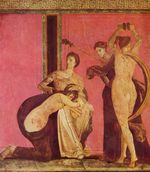Minerva
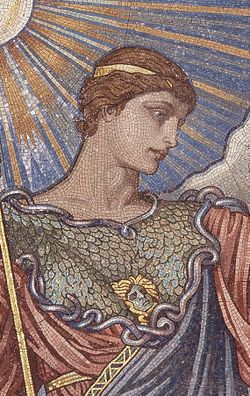
|
|
|
Practices and beliefs
Imperial cult · festivals · ludi |
|
Priesthoods
College of Pontiffs · Augur |
|
Dii Consentes
Jupiter · Juno · Neptune · Minerva |
|
Other deities
Janus · Quirinus · Saturn · |
|
Related topics
Roman mythology |
Minerva (Etruscan: Menrfa, or Menrva) was the Roman goddess whom Hellenizing Romans from the second century BC onwards equated with the Greek goddess Athena. She was the virgin goddess of poetry, medicine, wisdom, commerce, weaving, crafts, magic, and the inventor of music.[1] She is often depicted with an owl, her sacred creature and is, through this connection, a symbol of wisdom.
This article focuses on Minerva in ancient Rome and in cultic practice. For information on Latin literary mythological accounts of Minerva, which were heavily influenced by Greek mythology, see Pallas Athena, where she is one of three virgin goddesses along with Artemis and Hestia, known by the Romans as Diana and Vesta.
Contents |
Etruscan Menrva
The name "Minerva" is imported from the Etruscans who called her Menrva. Extrapolating from her Roman nature, it is assumed that in Etruscan mythology, Menrva was the goddess of wisdom, war, art, schools and commerce. She was the Etruscan counterpart to Greek Athena. Like Athena, Menrva was born from the head of her father, Jupiter (Greek Zeus).
By a process of folk etymology, the Romans could have confused the phones of her foreign name with those of the root men- in Latin words such as mens meaning "mind", perhaps because one of her aspects as goddess pertained to the intellectual. The word mens has the Proto-Indo-European mn- stem, linked with memory as in Greek Mnemosyne (μνημοσύνη) and mnestis (μνῆστις: memory, remembrance, recollection).
Cult in Rome
Menrva was part of a holy triad with Tinia and Uni, equivalent to the Roman Capitoline Triad of Jupiter-Juno-Minerva. Minerva was the daughter of Jupiter.
As Minerva Medica, she was the goddess of medicine and doctors. As Minerva Achaea, she was worshipped at Luceria in Apulia where votive gifts and arms said to be those of Diomedes were preserved in her temple.[2][3]
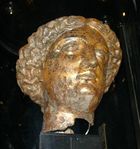
In Fasti III, Ovid called her the "goddess of a thousand works." Minerva was worshipped throughout Italy, though only in Rome did she take on the warlike character shared by Athena. Her worship was also taken out to the empire — in Britain, for example, she was conflated with the local wisdom goddess Sulis.
The Romans celebrated her festival from March 19 to March 23 during the day which is called, in the neuter plural, Quinquatria, the fifth after the Ides of March, the nineteenth, an artisans' holiday . A lesser version, the Minusculae Quinquatria, was held on the Ides of June, June 13, by the flute-players, who were particularly useful to religion. In 207 BC, a guild of poets and actors was formed to meet and make votive offerings at the temple of Minerva on the Aventine hill. Among others, its members included Livius Andronicus. The Aventine sanctuary of Minerva continued to be an important center of the arts for much of the middle Roman Republic.
Minerva was worshipped on the Capitoline Hill as one of the Capitoline Triad along with Jupiter and Juno, at the Temple of Minerva Medica, and at the "Delubrum Minervae" a temple founded around 50 BC by Pompey on the site now occupied by the church of Santa Maria sopra Minerva facing the present-day Piazza della Minerva.
In modern usage
Universities and educational establishments
As patron goddess of wisdom, Minerva frequently features in statuary, as an image on seals, and in other forms, at educational establishments, including:
- Minerva is the Goddess of Delta Sigma Theta Sorority, Inc.
- Minerva as a bronze head bust over the main entrance of the Main Library of the University of California, Berkeley.
- The Minerva head has been associated with the Chartered Society of Designers since its inception in 1930 and has been redefined several times during the history of the Society by notable graphic designers. The current logo was established in 1983.
- Minerva is the symbol of the University of Porto.
- A statue of Minerva is located in the center of La Sapienza University, the most important university of Rome.
- Minerva is displayed in front of Columbia University's Low Memorial Library as "Alma Mater."
- Above the entrance to the University of Vienna main building, there is a sculpture work titled "The Birth of Minerva".[4]
- A statue of Minerva adorns the library at the United States Military Academy
- Minerva is the name of a language school in Ruse, Bulgaria.
- Minerva is the name of a female residence at the University of Stellenbosch in South Africa.
- Minerva is displayed to the East of University of North Carolina at Greensboro's Elliot University Center as a statue.
- The SUNY Potsdam campus in Potsdam, NY is home to multiple statues of Minerva and a cafe named after her.
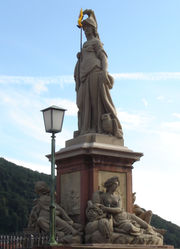
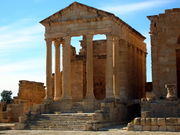
- Minerva is featured on the seals and logos of many institutions of higher learning:
- the University of Louisville official seal
- the University of North Carolina at Greensboro official seal
- University of Lincoln. Minerva's head is used as the logo of this UK University. There is a tradition within the Lincoln rugby union team and it is thought they are the Knights of Minerva, each match being won in her honour.
- University at Albany, The State University of New York. Minerva is still venerated by seniors and their 'torch bearers' during a pre-graduation ritual called "Torch Night" there.
- the University of Alabama
- the University of Virginia
- Union College, New York. Union College has also used Minerva as the name of their new academic and social "Third Space" program, the Minerva House System; and, also here, Minerva is the goddess of Theta Delta Chi.
- UFRJ, the Federal University of Rio de Janeiro, in Brazil.
- Escola Politécnica da USP, Polytechnic School of University of São Paulo, in Brazil.
- Ghent University, in Belgium
- American Academy of Arts & Sciences, in Cambridge, Mass. The seal's principal figure is Minerva - a symbol appropriate for an organization created in the midst of the American Revolution and dedicated to the cultivation of every art and science to "advance the interest, honour, dignity, and happiness of a free, independent, and virtuous people."
- Minerva is also the name of the oldest student-association of Leiden, the Netherlands (Leiden University).
- Minerva decorates the keystone over the main entrance to the Boston Public Library beneath the words, "Free to all." BPL was the original public-financed library in America and, with all other libraries, is the long-term memory of the human race.
- The annual prize for the best Politics student in Liverpool Hope University in the UK is called the Minerva Prize, both because of the association with wisdom and knowledge and because there is a statue of Minerva on the dome of Liverpool Town Hall, the seat of local politics in the city.
- Minerva is the Goddess of the Sigma Alpha Epsilon Fraternity. Fraternity Brothers are known as Loyal Sons of Minerva.
- Minerva is the name of a remote learning facility at Bath Spa University in England, UK.
- Minerva is featured on the seal of the University of Science and Arts of Oklahoma.
- Minerva is featured on the seal of the "Escuela Comercial Cámara de Comercio", in Mexico, founded in 1923.
- A statue of Minerva stands in the entrance to Main Building at Wells College in Aurora, NY. On the last day of spring semester classes, graduating seniors kiss Minerva's feet for luck and lifelong wisdom.
- Minerva is the patroness of the Federal University of Rio de Janeiro, Brazil.
- Minerva is featured in the logo of The Mac.Robertson Girls' High School, Australia.
- Minerva is featured in the logo of Kelvinside Academy, Glasgow, Scotland
- Minerva is featured on the seals of many schools and colleges: on that of Union College in Schenectady, NY, the motto is (translated from the French) "Under the laws of Minerva, we are all brothers."
- Minerva is the patroness of the Union Philosophical Society of Dickinson College in Carlisle, Pennsylvania.
- The Yale School of Architecture in New Haven, Connecticut, features a Roman marble statue of Minerva in its 4th floor atrium.
- The Minerva head is displayed outside The Natural History Museum, Bergen, Norway
- The seal for the University of Louisville includes a large head of Minerva.
- McGill University's web interface is called Minerva.
- Milne Library at SUNY Geneseo has a statue of Minerva in their lobby.
Societies and governmental use

- The Minerva head has been associated with the Chartered Society of Designers since its inception in 1930 and has been redefined several times during the history of the Society by notable graphic designers. The current logo was established in 1983.
- The Seal of California depicts the Goddess Minerva having sprung full grown from the brain of Jupiter. This was interpreted as analogous to the political birth of the State of California without having gone through the probation period of being a Territory.
- In the early 20th century, Manuel José Estrada Cabrera, President of Guatemala, tried to promote a "Cult of Minerva" in his country; this left little legacy other than a few interesting Hellenic style "Temples" in parks around Guatemala.
- According to John Robison's Proofs of a Conspiracy (1798), the third degree of the Bavarian Illuminati was called Minerval or Brother of Minerva, in honor of the goddess of learning. Later, this title was adopted for the first initiation of Aleister Crowley's OTO rituals.
- Minerva is the logo of the world famous German "Max Planck Society for the Advancement of Science" (Max-Planck-Gesellschaft)
- The helmet of Minerva serves as the crest of the distinctive unit insignia for Walter Reed Army Medical Center in Washington, D.C.
- Minerva is displayed on the Medal of Honor, the highest military decoration awarded by the United States government.
- A large mozaic of Menerva is the focal art piece in the great room of the U.S. Library of Congress.
- Minerva consulting & communication is the Belgian communication agency specialized in increasing the visibility of EU funded research projects. "Let Minerva, the ancient Roman Goddess of Wisdom, inspire the way you communicate!"
Public monuments and places

- A small Roman shrine to Minerva (the only one still in situ in the UK) stands in Handbridge, Chester. It sits in a public park, overlooking the River Dee.
- Minerva circle is one of the famous and busiest circles in Bangalore. It gets its name from an eponymous movie theatre that used to be located there.
- The Minerva Roundabout in Guadalajara, Mexico, located at the crossing of the López Mateos, Vallarta, López Cotilla, Agustín Yáñez and Golfo de Cortez avenues, features the goddess standing on a pedestal, surrounded by a large fountain, with an inscription which says "Justice, wisdom and strength guard this loyal city".
- Minerva is displayed as a statue in the Minneapolis Central Library in downtown Minneapolis, Minnesota.
- Minerva is displayed as a statue in Pavia near the train station, and is considered as an important landmark in the city.
- A statue of Minerva stands atop the dome of the Mitchell Library in Glasgow, Scotland.
- A seven foot statue of Minerva stands at the highest point in Brooklyn, overlooking New York Harbor, located in Green-Wood Cemetery.
- A bronze statue of Minerva lies in monument square Portland, Maine. "Our Lady of Victories Monument" dedicated 1891, Richard Morris Hunt and Franklin Simmons.
Literature
- Minerva is referred to in Robert Frost's poem, Stars.
- In the Harry Potter series by J. K. Rowling, the head of Gryffindor house and [deputy] headmistress of Hogwarts is Minerva McGonagall.
- The name of a ship carrying several of the main characters in the three books of the Baroque Cycle by Neal Stephenson
- In the fifth book of the Artemis Fowl series, Artemis Fowl and the Lost Colony, a rather clever main character in the book is named Minerva.
See also
Footnotes and references
- ↑ Candau, Francisco J. Cevallos (1994). Coded Encounters: Writing, Gender, and Ethnicity in Colonial Latin America. University of Massachusetts Press. pp. 215. ISBN 0870238868. http://books.google.com/books?isbn=0870238868.
- ↑ Aristotle Mirab. Narrat. 117
- ↑ Schmitz, Leonhard (1867). "Achaea (2)". In Smith, William. Dictionary of Greek and Roman Biography and Mythology. 1. Boston. pp. 8. http://www.ancientlibrary.com/smith-bio/0017.html
- ↑ AC.at
- Origins of English History see Chapter Ten.
- Romans in Britain - Roman religion and beliefs see The Roman gods.
Secondary sources
This article incorporates text from the public domain Dictionary of Greek and Roman Biography and Mythology by William Smith (1870). See page 1090
|
||||||||||||||||||||||
